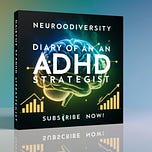We've all experienced that heart-stopping moment: you're about to leave, and your keys have disappeared. The frantic search begins, frustration mounts, and you're left feeling defeated. For many people with ADHD, this scenario is all too familiar.
It's not just keys; it's misplaced papers, overflowing drawers, and that "temporary" drop zone that morphs into a mountain of clutter. But here's the thing: it's not laziness, it's a brain wired for a different kind of journey.
Living with ADHD is like having a mind that's constantly buzzing with activity, ideas flitting in and out, making it a challenge to stay focused on the mundane, like putting things back where they belong. The sources explain that this is often linked to difficulties with executive function – those mental processes that help us plan, organise, and manage time.
Think of it as having a super-powered engine, but a slightly wonky steering wheel.
But don't despair! Even with ADHD, you can create a calmer, more organised space, and reclaim your energy and peace of mind.
My approach to taming the ADHD clutter monster is based on a simple three-step system: Place, Retrieve, Return.
Step one is all about creating a "Place" for everything. Every item, no matter how small, needs a designated home, a specific spot where it lives. This could be a hook by the door for keys, a tray for incoming mail, or labelled drawers for different categories. Here's the key for ADHD brains: make it convenient!
Frequently used items should be front and centre, easy to spot and grab. This eliminates the temptation to leave things out "just for a second" – because let's be honest, those seconds often turn into lost items.
Next comes "Retrieve". Need something? Head straight to its designated home and pick it up. Sounds easy, right? Not always. ADHD can make us "blind" to objects, even when they're right in front of us. Our brains can filter out visual information, creating those "I looked everywhere!" moments, even when the item was staring us in the face. The solution?
Embrace organisation as your secret weapon! Clear surfaces, minimal distractions, and visual cues that shout, "Here I am!" Think colour-coding, bold labels, or clear containers that allow you to see what's inside.
Now for the most crucial step: "Return". After using an item, fight that urge to set it down "just for a second". Make a pact with yourself to return it immediately to its designated home. Consistency is key here.
Each time you deviate, you're reinforcing the habit of clutter, making it harder to find things later. It's like training a mental muscle. With practice, "return" becomes automatic, a smooth move in your daily dance with your belongings.
Let's be realistic, organising a chaotic space can feel overwhelming, especially when clutter has taken over. My advice? Break it down into smaller, manageable chunks. Set a timer for an hour and focus on one specific zone. A great motivational trick is to take before and after photos. That visual transformation? It's pure gold for the ADHD brain, a tangible reminder of your achievement.
Taming the ADHD clutter monster isn't about striving for magazine-worthy perfection. It's about creating a functional and supportive environment that works in harmony with your unique brain wiring. With patience, consistency, and this three-step system, you can transform your space into a peaceful sanctuary, and finally bid farewell to those frustrating "Where are my keys?!" moments.
















Share this post